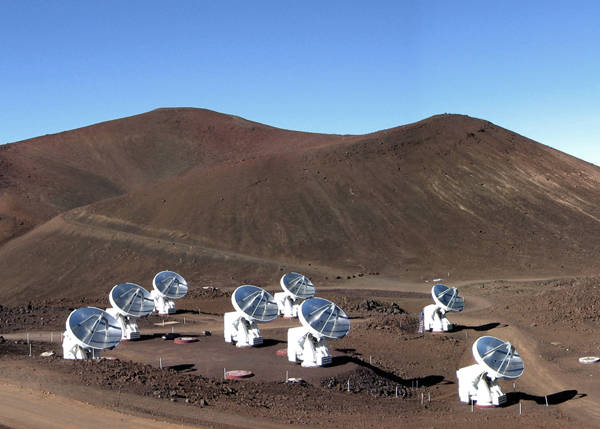The high-powered telescope community atop Mauna Kea has made scores of key scientific discoveries over the years while keeping its collective eyes focused on the heavens nightly, weather permitting.
But the ongoing protest over the planned construction of the Thirty Meter Telescope has brought the world-renowned astronomy outpost down to Earth, stopping dozens of long-planned projects, such as the observation of supernovae, a massive black hole, star systems, asteroids and far-off exoplanets.
“It’s always sad to give up good observing time, because these telescopes are in great demand all around the world,” said Jessica Dempsey, deputy director of the East Asian Observatory, which is affiliated with three telescopes on the summit.
The 13 telescopes of the Maunakea Observatories are expected to remain shuttered through the weekend and likely beyond following Tuesday’s decision to bring 25 employees off the mountain due to safety and access issues.
“The safety of our staff is our absolute priority for everything we do on the mauna,” Dempsey said.
Hundreds of protesters were blocking the base of the mountain, where Mauna Kea Access Road meets Daniel K. Inouye Highway, all this week, fending off construction of the next member of Mauna Kea community of telescopes, the $1.4 billion TMT.
“We’re in a holding pattern,” said Doug Simons, director of the Canada- France-Hawaii Telescope.
Facilities and high-tech instrumentation worth many millions of dollars are potentially vulnerable.
“This isn’t a camera you can buy off the shelf,” Dempsey said. “A lot of these are very fickle. These instruments need a lot of love and tender loving care, and often this means daily attention.”
Simons said that while the summit is a virtual ghost town, the observatories are still being monitored remotely 24/7 from their sea-level headquarters in Hilo and Waimea.
The greatest concern, he said, are the instruments that operate optimally at extremely cold temperatures using liquid cryogen. Since no one is on the mountain to refill cyrogen tanks, those instruments are slowly warming and could be damaged. They will need to be re-cooled before they can be used again.
Simons said the summit has endured shutdowns in the past due to extreme weather, but never for more than a week or so.
“I would be more concerned if this goes on for a month,” he said.
While many of the telescopes can be operated remotely, it becomes too risky if no technician is on-site.
“If they encounter serious technical difficulty — such as shutter stuck open during bad weather — then it puts the sensitive optics and the instrumentation at risk,” said Rich Matsuda, chief of operations at WM Keck Observatory.
In the meantime, science and potential discoveries are being lost with dozens of projects on hold.
For example, UCLA astrophysicist Andrea Ghez was on island this week hoping to peer at the galactic center at Keck as part of a project to prove there is a supermassive black hole at the center of the Milky Way.
There is a limited summer window for those who want to look at the galactic center.
“Normally, when you lose telescope time, you don’t get it back,” Simons said.
Astrophysicist Thayne Currie with the NASA-Ames Research Center and Subaru Telescope said his scheduled project was ruined by the shutdown.
“We had precious telescope time with Subaru’s exoplanet imaging instrument. We were planning crucial tests that will help us someday image another Earth. All that time was lost. We will not be able to make it up in the foreseeable future. At some point I worry about the state of our instrument,” Currie said in an email.
Some other interrupted projects:
>> At the UKIRT observatory, scientists were hoping to spot a star system with seven Earth-size planets in orbit with three of them in the habitable “Goldilocks” zone where water exists as a liquid and potentially suitable for life. The problem is that observations have to be done at specific times when the planets transit the central star and each other.
>> At the Canada-France-Hawaii Telescope, the Megacam instrument was working with University of Hawaii astronomers to follow up observations from the UH Pan-STARRS telescope on Maui targeting potential asteroids.
>> At the James Clerk Maxwell Telescope, a team from UH intended to discover new stars in two active star-forming regions in the direction of the Taurus constellation. The work aims to discover new information about star formation.
>> At the Submillimeter Array, astronomers planned coordinated observations of the galactic center along with the Chandra X-ray and Spitzer infrared space observatories. The Spitzer will be retired in January, so this was the last opportunity for the coordinated observations.
Dempsey said the TMT will be “an amazing addition” that will complement the existing telescopes.
“The TMT is going to add an incredible new capability to the type of science we can do on Mauna Kea,” she said. “But its complementary aspect. It doesn’t mean suddenly that you don’t need the other telescopes on the mauna to do the science they are doing.”
The TMT, one of three next-generation “Extremely Large Telescopes” planned across the globe, was scheduled to start construction in 2015. But construction crews were blocked from reaching the work site on at least two occasions despite arrests and other attempts by law enforcement to support TMT’s right to access the summit.
According to the TMT partnership of the University of California and Caltech plus the national research organizations of Japan, India, China and Canada, the new observatory is expected to be one of the most powerful optical telescopes in the world, capable of seeing more than 13 billion light-years away.
Honolulu Star-Advertiser writer Kevin Dayton contributed to this report.
Correction: An earlier version of the story said the observatories would have to be recooled due to warming. It is the instruments on the observatories that need to be recooled.






